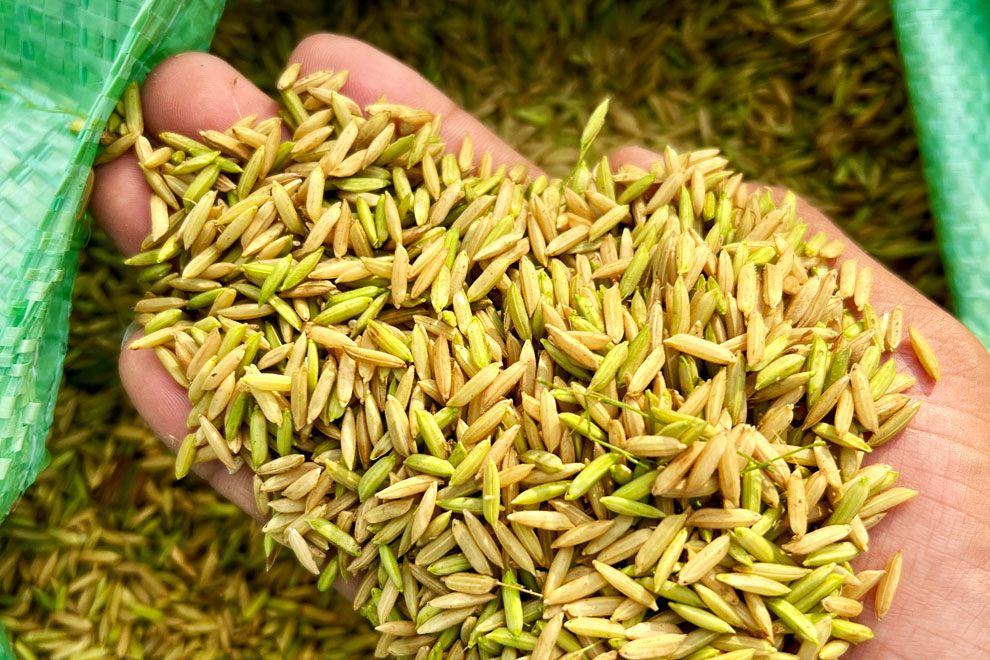Tags
Cambodia expanding rice markets, eyes Iraq

Freshly harvested rice in Takeo province’s Mongkul Borei district. Hong Menea
In addition to China and the EU, the Kingdom’s largest rice markets, countries such as Indonesia, the Philippines and Iraq are also emerging as potential and target markets for Cambodian rice, according to a senior official at the Ministry of Agriculture, Forestry and Fisheries.
Citing the Statista website, a global data forum on statistics, ministry secretary of state Yang Saing Koma said on December 3 that the largest global rice importers are China, the Philippines, the EU, Iraq, Nigeria and Indonesia, with Vietnam in the seventh slot.
He added that among these markets, Cambodia has already captured some in China and Europe, while Indonesia and the Philippines are potential markets where the country has been gradually starting to export.
“We are currently marketing in the Philippines and Indonesia, and Iraq could be our market in the future. India is the world’s largest exporter of rice, followed by Thailand, and Vietnam in third rank, while Cambodia is currently eighth and has the potential to move up to the fifth-largest in the future,” he stated.
“Vietnam ranks seventh in rice imports, while it also ranks third in terms of rice exports. This country is also the largest importer of rice from Cambodia, importing between three to four million tonnes a year,” he added.
Saing Koma noted that in order to achieve the goal of exporting one million tonnes of rice per year and become the fifth-largest exporter of the commodity in the future, the ministry has been implementing important policies, especially the fifth and sixth priority policies launched by the government on November 20.
The policies, parts of the new government’s Pentagonal Strategy-Phase I, aim to promote agribusiness production, find markets and maintain the balance of prices through financing programmes, deploying officials in communes and developing modern agricultural communities.
“We are enhancing incentives for farmers to cultivate fragrant rice using genetically pure seeds. This variety of rice is in high demand by local mills. The production of this cultivar for export provides a more favourable and stable price compared to other dry season varieties,” he explained.
“The utilisation of pure seeds, combined with the correct application of principles and techniques in field management, also contributes to achieving high yields,” he added.
Chan Sokheang, president of the Cambodia Rice Federation (CRF) – the Kingdom’s apex rice industry body – also noted that CRF has consistently supported the ministry in implementing the policies set by the government, particularly the agricultural strategy, which is crucial for the rice sector.
“CRF has continually assisted the government in promoting the successful export of rice to international markets. We have sought overseas markets by participating in exhibitions in other countries and have strived to find export partners for new markets, as we want the world to know and taste Cambodia’s delicious rice,” he said.
As of the beginning of November this year, rice cultivation covered more than 3.6 million hectares and produced 6.2 million tonnes, with an anticipated total yearly yield of more than 6.3 million tonnes by year’s end, according to a report from the ministry.
During the same period, agricultural exports remained high at more than 6.2 million tonnes, valued at over $3.5 billion, to 74 destination countries. The Kingdom achieved more than 520,000 tonnes of exported rice worth over $458 million, including exports to Indonesia, a new destination.
https://www.phnompenhpost.com/national/cambodia-expanding-rice-markets-eyes-iraqPublished Date: December 5, 2023





